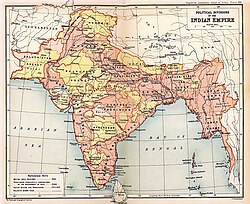Remove ads
บริติชราช (อังกฤษ: British Raj) เป็นการปกครองของพระมหากษัตริย์อังกฤษในอนุทวีปอินเดีย[6] เรียกอีกอย่างว่า การปกครองส่วนพระองค์ในอินเดีย[7] (อังกฤษ: Crown rule in India) หรือ การปกครองโดยตรงในอินเดีย[8] (Direct rule in India) โดยดำรงอยู่ตั้งแต่ ค.ศ. 1858 จนถึง 1947[9] ภูมิภาคที่อยู่ภายใต้การปกครองของบริเตนแห่งนี้เรียกกันโดยทั่วไปว่า อินเดีย ตามการใช้งานในปัจจุบัน รวมถึงพื้นที่ในปกครองของสหราชอาณาจักรโดยตรง ซึ่งเรียกแบบโดยรวมว่าบริติชอินเดีย ตลอดจนรัฐในปกครองของเจ้าพื้นเมือง แต่เนื่องจากบรรดารัฐดังกล่าวอยู่ภายใต้อธิปไตยชั้นสูงสุดโดยบริเตน จึงทำให้พื้นที่ดังกล่าวเรียกว่ารัฐมหาราชา บางครั้งภูมิภาคแห่งนี้เรียกว่า บริติช-อินเดีย หรือ จักรวรรดิอินเดีย ถึงแม้ว่าจะเป็นชื่อเรียกอย่างไม่เป็นทางการก็ตาม[10]
อินเดีย | |||||||||||||
|---|---|---|---|---|---|---|---|---|---|---|---|---|---|
| ค.ศ. 1858–ค.ศ. 1947 | |||||||||||||
 แผนที่ของอินเดียใน ค.ศ. 1909 โดยสีชมพูแสดงถึงอินเดียของบริเตนในทั้งสองระดับสี และสีเหลืองแสดงถึงรัฐของเหล่ามหาราชา | |||||||||||||
| สถานะ | โครงสร้างทางการเมืองของจักรวรรดิบริติช (ซึ่งประกอบด้วยอินเดียของบริเตน[a] และรัฐมหาราชา[b])[1] | ||||||||||||
| เมืองหลวง | กัลกัตตา[2][c] (ค.ศ. 1858–1911) นิวเดลี (ค.ศ. 1911/1931[d]–1947) | ||||||||||||
| ภาษาราชการ | อังกฤษและอูรดู[4][5] | ||||||||||||
| การปกครอง | รัฐบาลอาณานิคมของบริเตน | ||||||||||||
| จักรพรรดิ | |||||||||||||
• ค.ศ. 1858–1901 | วิกตอเรีย | ||||||||||||
• ค.ศ. 1901–1910 | เอ็ดเวิร์ดที่ 7 | ||||||||||||
• ค.ศ. 1910–1936 | จอร์จที่ 5 | ||||||||||||
• ค.ศ. 1936 | เอ็ดเวิร์ดที่ 8 | ||||||||||||
• ค.ศ. 1936–1947 | จอร์จที่ 6 | ||||||||||||
| อุปราช | |||||||||||||
• ค.ศ. 1858–1862 (คนแรก) | ชาร์ล แคนนิง | ||||||||||||
• ค.ศ. 1947 (คนสุดท้าย) | หลุยส์ เมานต์แบ็ตเทน | ||||||||||||
| รัฐมนตรีว่าการอินเดีย | |||||||||||||
• ค.ศ. 1858–1859 (คนแรก) | เอ็ดเวิร์ด สแตนเลย์ | ||||||||||||
• ค.ศ. 1947 (คนสุดท้าย) | วิลเลียม แฮร์ | ||||||||||||
| สภานิติบัญญัติ | สภานิติบัญญัติจักรวรรดิ | ||||||||||||
| ประวัติศาสตร์ | |||||||||||||
| 10 พฤษภาคม ค.ศ. 1857 | |||||||||||||
| 2 สิงหาคม ค.ศ. 1858 | |||||||||||||
• พระราชบัญญัติอิสรภาพของอินเดีย | 18 กรกฎาคม ค.ศ. 1947 | ||||||||||||
| 14 และ 15 สิงหาคม ค.ศ. 1947 | |||||||||||||
| สกุลเงิน | รูปีอินเดีย | ||||||||||||
| |||||||||||||
| |||||||||||||
ก่อนหน้ายุคบริติชราช อังกฤษได้ปกครองบรรดาดินแดนในอนุทวีปอินเดียผ่านบริษัทอินเดียตะวันออกกว่าร้อยปี ซึ่งบริษัทนี้มีกองเรือและกองทหารเป็นของตนเอง การปกครองโดยบริษัทฯได้สิ้นสุดลงเมื่อมีการตราพระราชบัญญัติรัฐบาลอินเดีย ค.ศ. 1858 ในการนี้ สมเด็จพระราชินีนาถวิกตอเรียได้สถาปนาพระองค์เป็นจักรพรรดินีนาถแห่งอินเดีย ทรงส่งขุนนางไปปกครองอินเดียในตำแหน่งอุปราชและข้าหลวงต่างพระองค์ ต่อมาภายหลังสงครามโลกครั้งที่สอง ก็ได้มีการแบ่งอินเดียแบ่งออกเป็นสองประเทศในเครือจักรภพคืออินเดีย (ประเทศอินเดียในปัจจุบัน) และปากีสถาน (ประเทศปากีสถานและประเทศบังกลาเทศในปัจจุบัน) ส่วนพม่านั้นได้แยกตัวออกจากรัฐบาลบริติชอินเดียในปี ค.ศ. 1937 และรัฐบาลสหราชอาณาจักรปกครองโดยตรงตั้งแต่บัดนั้น
บริติชราชประกอบไปด้วยดินแดนที่เป็นประเทศอินเดียและบังกลาเทศในปัจจุบัน อีกทั้งยังมีเอเดน (1839-1937), พม่าตอนบน (1885-1937), และพม่าตอนล่าง (1853-1937), โซมาลิแลนด์ของบริเตน (1884-98), โอมานและมัสกัต (1892-1947), บาห์เรน (1861-1947), กาตาร์ (1916-47), คูเวต (1899-1947), รัฐทรูเชียล (1820-1947), และ สเตรตส์เซตเทิลเมนต์ (1826-67) นอกจากนี้ บริติชราชยังมีเขตอำนาจถึงดินแดนในปกครองอังกฤษในตะวันออกกลาง เงินตรารูปีอินเดียใช้กันอย่างแพร่หลายในอนุทวีปอินเดีย อย่างไรก็ตาม ในบรรดาดินแดนในบังคับของอังกฤษเหล่านี้ บริติชซีลอน (ประเทศศรีลังกาในปัจจุบัน) มีฐานะเป็นคราวน์โคโลนีที่ไม่ขึ้นกับรัฐบาลอุปราชแห่งอินเดีย
ราชอาณาจักรเนปาลและภูฏาน แม้มีความขัดแย้งกับสหราชอาณาจักร แต่ก็ลงนามทำสนธิสัญญากันและได้รับการยอมรับในฐานะรัฐเอกราชและไม่ใช่ส่วนหนึ่งของบริติชราช[11][12] ราชอาณาจักรสิกขิมได้รับการตั้งให้เป็นรัฐราชวงศ์หลังการลงนามในสนธิสัญญาอังกฤษ-สิกขิมในปี 1862 อย่างไรก็ตาม ไม่เคยมีการตกลงในประเด็นว่าด้วยความมีอธิปไตย มัลดีฟส์เป็นรัฐในอารักขาของบริเตนตั้งแต่ปี 1867 ถึงปี 1965 ซึ่งไม่ใช่ส่วนหนึ่งในบริติชราช

Remove ads
อินเดียในยุคของบริติชราช ประกอบด้วยดินแดนสองประเภท คือ บริติชอินเดีย ปกครองและบริหารโดยรัฐบาลกลาง กับ รัฐพื้นเมือง (รัฐมหาราชา) ปกครองโดยเจ้าอินเดียแต่บริหารโดยรัฐบาลกลาง ทั้งนี้ในมาตรา 18 ของพระราชบัญญัติจำกัดความ ค.ศ. 1889 (Interpretation Act) บัญญัติไว้ว่า:
- (4.) คำว่า "บริติชอินเดีย" นั้นหมายถึงดินแดนและสถานที่ทั้งปวงในแผ่นดินแว่นแคว้นในสมเด็จฯ ซึ่งขณะนี้อยู่ในปกครองโดยสมเด็จฯผ่านทางข้าหลวงต่างพระองค์แห่งอินเดีย หรือผ่านข้าหลวงหรือเจ้าพนักงานอื่นใดอันขึ้นกับข้าหลวงต่างพระองค์แห่งอินเดีย
- (5.) คำว่า "อินเดีย" นั้นหมายถึงบริติชอินเดียพร้อมด้วยดินแดนของบรรดาเจ้าหรือผู้นำพื้นเมืองภายใต้พระราชอำนาจในสมเด็จฯ ซึ่งทรงบริหารผ่านข้าหลวงต่างพระองค์แห่งอินเดีย หรือผ่านข้าหลวงหรือเจ้าพนักงานอื่นใดอันขึ้นกับข้าหลวงต่างพระองค์แห่งอินเดีย[1]
โดยทั่วไป คำว่า "บริติชอินเดีย" นั้นใช้เพื่อสื่อถึงอนุทวีปอินเดียภายใต้การปกครองของบริษัทอินเดียตะวันออกระหว่าง ค.ศ. 1600 ถึง 1858 นอกจากยังคำว่าบริติชอินเดีย ยังใช้สื่อถึงชาวอังกฤษในอินเดียด้วย ส่วนคำว่า "จักรวรรดิอินเดีย" นั้นเป็นคำที่ไม่ใช้ในสารบบกฎหมาย แต่เนื่องจากกษัตริย์อังกฤษทรงปกครองอินเดียในพระอิสริยยศ จักรพรรดิแห่งอินเดีย ดังนั้นเวลากษัตริย์อังกฤษมีพระราชดำรัสไปยังรัฐสภาจึงมักจะเรียกอินเดียว่า "จักรวรรดิอินเดีย" ทั้งนี้ หนังสือเดินทางที่ออกโดยรัฐบาลบริติชอินเดียนั้น ปรากฏคำว่า "Indian Empire" บนปก และปรากฏคำว่า "Empire of India" อยู่ด้านใน[13] นอกจากนี้ยังมีการสถาปนาเครื่องราชอิสริยาภรณ์ที่มีชื่อว่า เครื่องราชอิสริยาภรณ์อันสูงส่งยิ่งแห่งจักรวรรดิอินเดีย ด้วย
มณฑลขนาดใหญ่
ในช่วงเปลี่ยนผ่านสู่คริสต์ศตวรรษที่ 20 บริติชอินเดียประกอบด้วยมณฑลทั้งสิ้น 8 มณฑล ซึ่งมณฑลเหล่านั้นได้รับการปกครองโดยผู้ว่าราชการ หรือรองผู้ว่าราชการ
| มณฑล (และดินแดนในปัจจุบัน) |
พื้นที่รวม | ประชากรปี 1901 (ล้านคน) |
|---|---|---|
| อัสสัม (รัฐอัสสัม, รัฐอรุณาจัลประเทศ, รัฐเมฆาลัย, รัฐมิโซรัม, รัฐนาคาแลนด์) |
130,000 ตารางกิโลเมตร 50,000 ตารางไมล์ |
6 |
| เบงกอล (ประเทศบังกลาเทศ, รัฐเบงกอลตะวันตก, รัฐพิหาร, รัฐฌารขัณฑ์ และรัฐโอฑิศา) |
390,000 ตารางกิโลเมตร 150,000 ตารางไมล์ |
75 |
| บอมเบย์ (แคว้นสินธ์ และบางส่วนของรัฐมหาราษฏระ, รัฐคุชราต และรัฐกรณาฏกะ) |
320,000 ตารางกิโลเมตร 120,000 ตารางไมล์ |
19 |
| พม่า (ประเทศพม่า) |
440,000 ตารางกิโลเมตร 170,000 ตารางไมล์ |
9 |
| มณฑลกลางและเบราร์ (รัฐมัธยประเทศ และบางส่วนของรัฐมหาราษฏระ, รัฐฉัตตีสครห์ และรัฐโอฑิศา) |
270,000 ตารางกิโลเมตร 100,000 ตารางไมล์ |
13 |
| มัทราส (รัฐอานธรประเทศ, รัฐทมิฬนาฑู และบางส่วนของรัฐเกรละ, รัฐกรณาฏกะ, รัฐโอฑิศา และรัฐเตลังคานา) |
370,000 ตารางกิโลเมตร 140,000 ตารางไมล์ |
38 |
| ปัญจาบ (แคว้นปัญจาบ, ดินแดนนครหลวงอิสลามาบาด, รัฐปัญจาบ, รัฐหรยาณา, รัฐหิมาจัลประเทศ, รัฐฉัตติสครห์ และดินแดนนครหลวงแห่งชาติเดลี) |
250,000 ตารางกิโลเมตร 97,000 ตารางไมล์ |
20 |
| สหมณฑล (รัฐอุตตรประเทศและรัฐอุตตราขัณฑ์) |
280,000 ตารางกิโลเมตร 110,000 ตารางไมล์ |
48 |
ในช่วงของการแบ่งเบงกอล (ค.ศ. 1905–1913) มณฑลอัสสัมและเบงกอลตะวันออกได้รับการก่อตั้งขึ้นในฐานะเขตผู้แทนพระองค์ ใน ค.ศ. 1911 มณฑลเบงกอลตะวันออก ถูกรวมกับมณฑลเบงกอลอีกครั้ง และมณฑลใหม่ทางตะวันออกได้กลายไปเป็นมณฑลอัสสัม, เบงกอล, พิหาร และโอฑิศา[14]
Remove ads
- ธงจักรวรรดิอินเดีย เป็นธงอย่างไม่เป็นทางการ
- ธงนาวี
- ธงข้าหลวงต่างพระองค์
Remove ads
Wikiwand in your browser!
Seamless Wikipedia browsing. On steroids.
Every time you click a link to Wikipedia, Wiktionary or Wikiquote in your browser's search results, it will show the modern Wikiwand interface.
Wikiwand extension is a five stars, simple, with minimum permission required to keep your browsing private, safe and transparent.
Remove ads


